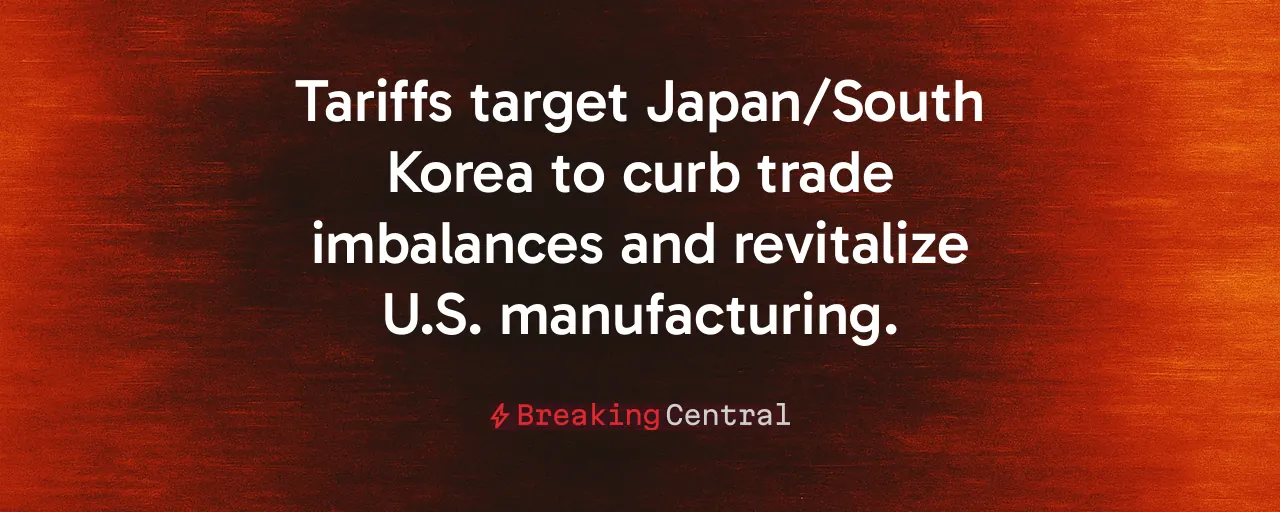A Bold Move to Reshape Trade
President Trump's announcement of a 25 percent tariff on all goods from Japan and South Korea, set to begin August 1, has sent shockwaves through global markets. The policy, framed as a push for fair trade, targets two of America's closest allies, both major suppliers of cars, electronics, and steel. The decision aims to address long-standing trade deficits and bring manufacturing jobs back home. However, it raises questions about the costs for American consumers and the strength of vital alliances.
The decision reflects long-standing frustrations over trade imbalances. For years, trade imbalances have frustrated policymakers. Last year, the U.S. ran a $79 billion deficit with Japan and $39 billion with South Korea. These gaps fuel arguments that foreign markets benefit unfairly from open access to American consumers while shielding their own industries. The tariffs signal a demand for reciprocity, a call to level the playing field.
The move aligns with a broader vision of economic independence. By pressuring allies to lower their own trade barriers or shift production to U.S. soil, the administration hopes to spark a manufacturing renaissance. Supporters see it as a long-overdue correction to decades of policies that favored global markets over American workers.
Why Tariffs Matter for American Jobs
At the heart of the tariff strategy lies a promise to revitalize U.S. industry. Domestic manufacturers, particularly in steel and autos, have struggled against cheaper foreign imports. Labor unions and factory workers view the tariffs as a lifeline, a chance to compete without the weight of uneven trade rules. Past tariff threats, like those leading to the 2020 U.S.-Mexico-Canada Agreement, forced concessions that boosted American exports.
Evidence suggests targeted pressure can work. When tariffs were placed on Chinese goods in 2019, some companies began diversifying supply chains, with a few relocating to the U.S. The hope is that Japan and South Korea, facing steep duties, will incentivize firms to build factories stateside, creating jobs in places like Ohio and Michigan.
National security also plays a role. Relying on Asia for critical goods like semiconductors and batteries leaves the U.S. vulnerable. Diversifying supply chains through tariffs could reduce that risk, ensuring essential industries have a stronger domestic footprint.
The Price of Protection
However, tariffs are not without trade-offs. Studies from the 2018-19 tariff waves show mixed results. While protected industries like steel saw modest job gains, downstream sectors, such as appliance manufacturing, faced higher costs and shed workers. American consumers bore the brunt, with estimates suggesting households paid an extra $1,300 annually due to price hikes.
Japan and South Korea supply roughly $188 billion in U.S. imports, from cars to smartphones. A 25 percent tariff could raise auto prices by 2 to 4 percent, hitting middle-class families hardest. Retailers, already grappling with supply-chain issues, may pass these costs directly to shoppers, fueling inflation concerns.
Retaliation is another worry. Both nations could slap duties on U.S. exports like soybeans, pork, or natural gas, hurting farmers and energy workers in states like Iowa and Texas. The ripple effects could disrupt global markets, with investors already rattled by the announcement.
Lessons From the Past
History offers insight into the tariff gamble. In the 1980s, U.S. pressure on Japan over autos and semiconductors led to voluntary export limits and new American factories. The 2007 U.S.-South Korea trade deal, revised in 2018, opened markets for U.S. vehicles. These examples show that leverage can yield results when paired with clear demands.
However, the 1930 Smoot-Hawley Act serves as a cautionary tale. Its high tariffs deepened the Great Depression, as trading partners retaliated and global commerce stalled. Today's interconnected economy makes such risks even greater, with supply chains spanning multiple continents.
A Strategy to Win Allies Over
For the tariffs to succeed, they must push Japan and South Korea toward concrete concessions. Both nations could agree to buy more U.S. agricultural products, energy, or defense equipment. Streamlining their complex auto standards or investing in U.S. chip plants could also defuse tensions. A trilateral working group to monitor trade balances might ensure progress without escalating into a full-blown trade war.
The administration could sweeten the deal with incentives. Tax breaks or deregulation for companies building U.S. factories would accelerate reshoring. Pairing tariffs with policies that boost American competitiveness, like workforce training or innovation grants, could maximize their impact.
Balancing Strength and Stability
Trump's tariff plan is a high-stakes bet on American resilience. It banks on the idea that strong leverage can force fairer trade terms while reviving industries hollowed out by global competition. If executed with precision, it could bring jobs, secure supply chains, and strengthen the economy.
Precision is key, however. Indefinite tariffs risk alienating allies and burdening consumers. Courts may also challenge the use of emergency powers, and Congress could push back. The administration must navigate these hurdles while keeping the public's trust.
Ultimately, the tariffs reflect a belief that America's economic future lies in self-reliance and fair trade. Whether they spark a manufacturing boom or ignite global friction depends on how boldly, and carefully, the strategy unfolds.
